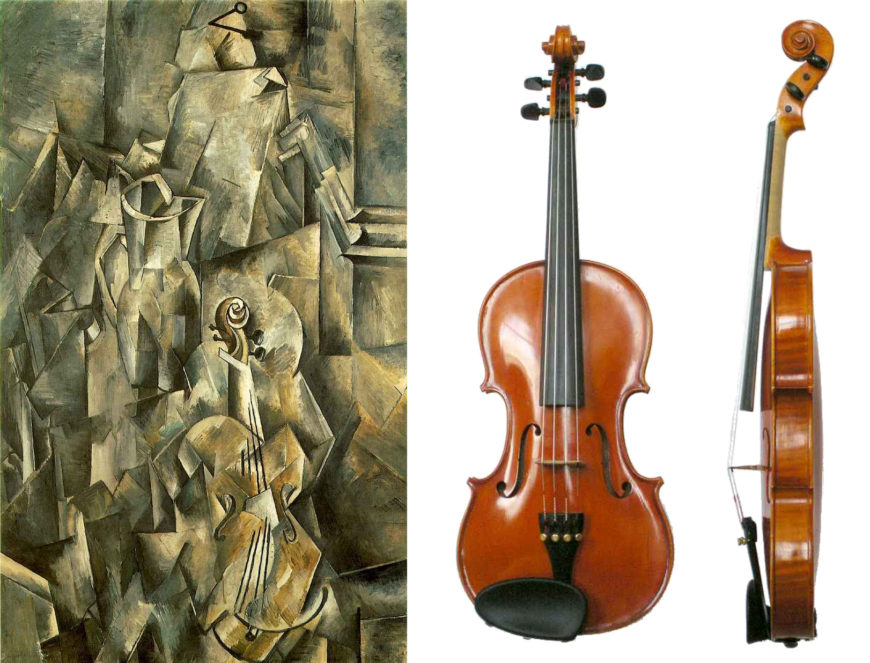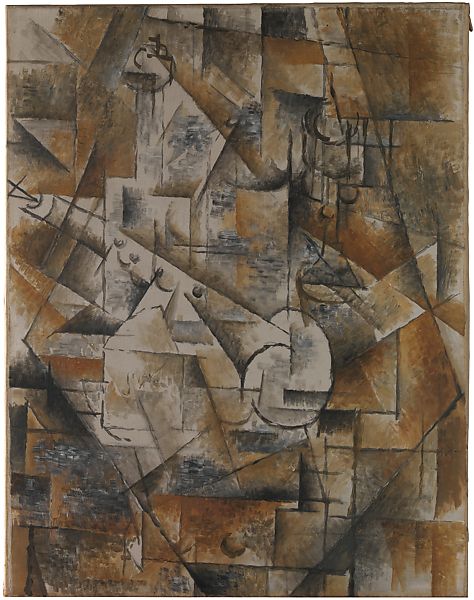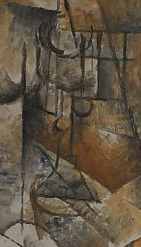Cubism and multiple perspectives

At first sight the objects in Georges Braque’s Pitcher and Violin appear arbitrarily distorted, but they are not. One tactic that Braque uses here is depicting objects from multiple perspectives. While most of Braque’s violin is depicted frontally, like an illustration in an encyclopedia, the scroll at the top of the neck is represented from the side, and the bridge that holds the strings over the neck and sound board has been flipped up.
The pitcher is also depicted mostly from the side, but we see the top rim from above on the left-hand side, while the spout is depicted from a slightly less elevated angle. Similarly, while Braque appears to have depicted the violin standing improbably on its bottom edge, it is more likely that we are expected to understand it as lying flat on a table. Thus, we are looking down on the violin at the same time as we look straight ahead at the body of the pitcher and the wall behind the table.
Cubism as higher truth
This use of multiple perspectives became a hallmark of the Cubist style, but Braque and Picasso never explained why they employed this technique. One common contemporary interpretation argued that the use of multiple perspectives allows greater truth and accuracy than the traditional naturalistic style that had dominated art since the Renaissance. In 1912, the writer and art critic Jacques Rivière argued that linear perspective creates unrealistic distortions. For example, if we stand in the middle of railroad tracks, they appear to converge and meet at a point, when in fact they remain parallel.
Braque represents the key parts of the violin from the most revealing angle. For example, the scroll is flipped to the side because if viewed from the front like the rest of the violin, it would not be visible at all. At the same time, though, if the scroll were viewed from the side, we would only see two of the tuning pegs, so Braque flips the view again to straight on so that all four pegs are visible.
Recognizing objects in Cubism

The subject of this still life may be difficult to discern, but with the help of the title we can begin to pick out the represented objects. The clarinet is the white rectangular shape in the left of the painting. Four finger holes extend up its length, which is shaded with chiaroscuro to suggest its tubular volume.

Note that while the bulk of the instrument is seen from the side, the opening at the base in the center of the painting is round, and a semicircle and schematic triangle at the other end by the edge of the canvas suggest the wedge-shaped cut out of the mouthpiece where the reed sits.
Above the clarinet’s finger holes, we can see a wine bottle with schematic, squared-off shoulders. Its transparency is indicated by the fact that we can see the clarinet through it. Notice that here, too, while we see the bulk of the bottle from the side, Braque has rendered the bottle’s mouth as a circle, as though seen from above, while a quarter-circle indicates the round base below.
With familiarity, we can begin to recognize objects in Cubist still-lifes even when they are not explicitly mentioned in the title. In the upper right quadrant of this painting there is a stemmed glass, again seen mostly from the side, but circles at the base, lip, and stem indicate the perfect roundness of those parts.
An art of conception, not perception
Monochromatic color and inconsistent lighting are more truthful means to depict reality than traditional naturalism. As the Impressionists had demonstrated, the appearance of objects changes radically in different kinds of light.
Monochromatic color eliminates the variables of lighting to represent objects in their true form, as we know them to be, rather than showing them distorted by our vision. For this reason, Cubism was often seen as an art of conception rather than perception. Cubist paintings represented the composite idea of objects that we have in our heads, rather than rendering objects from one point of view, at one moment in time, and in one kind of light.[1]
- Dr. Charles Cramer and Dr. Kim Grant, "Cubism and multiple perspectives," in Smarthistory, March 7, 2020, https://smarthistory.org/cubism-and-multiple-perspectives/ ↵

